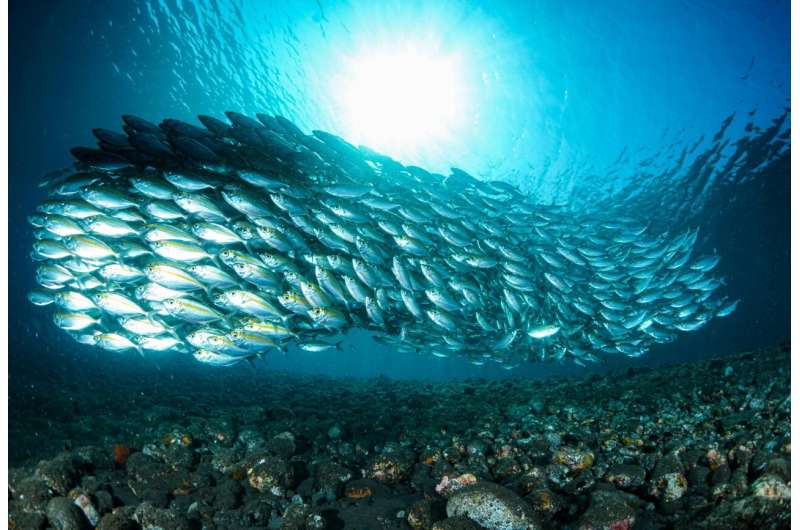This article has been reviewed according to Science X's editorial process and policies. Editors have highlighted the following attributes while ensuring the content's credibility:
fact-checked
proofread
A school of new data about how climate impacts fisheries

The changing climate has profound implications for the ocean, including waters that are warmer, more acidic, and less oxygenated. In addition, the ocean absorbs a huge amount of atmospheric carbon dioxide, an essential ingredient for the growth of phytoplankton near the sunlit surface. All of these changes affect marine life, but understanding exactly how is incredibly challenging.
Now, scientists at the U.S. National Science Foundation National Center for Atmospheric Research (NSF NCAR) have linked together multiple state-of-the-art computer models to create a detailed picture of how conditions in the atmosphere affect the ocean; how the ocean, in turn, affects the growth of phytoplankton and zooplankton; and finally, how the small fish that eat zooplankton (and the bigger fish that eat them) are impacted.
The result is an incredibly rich, high-resolution global dataset that stretches over multiple decades and can help answer a range of scientific questions about how oceans are changing. Ultimately, the work sets the stage for improved predictions of how a warming climate will impact fisheries, which is critical information to support sustainable management.
"We are really excited to make this ocean dataset available," said NSF NCAR scientist Kristen Krumhardt, who led the work. "There are so many questions that could be answered."
Details of the new dataset, which is freely available to the community, are published in the journal Progress in Oceanography. The work relied on the Cheyenne and Frontera supercomputers.
An amazing model
Conditions in the atmosphere can significantly impact the ocean. For example, the ocean absorbs an estimated 25% of annual human-produced carbon dioxide emissions and 90% of all the atmospheric warming associated with those emissions. Even so, simulations produced by Earth system modeling efforts do not typically produce data about the ocean that can be easily translated into useful information about fisheries.
This is due in part to the fact that ocean models are often run at low resolution (about 100 kilometers between grid points), which cannot capture the swirling eddies and smaller ocean features that are very important to marine life. By default, ocean models do not simulate biogeochemistry, which is a mixture of biology, chemistry, and geology that aims to describe the complex cycling of elements through the ocean, rocks, and life.
In particular, modeling ocean biogeochemistry allows scientists to simulate the ocean's net primary productivity, or its ability to change carbon and inorganic nutrients—the building blocks of life—into phytoplankton in the presence of sunlight. Information about net primary productivity is critical to understanding fisheries.
For the new study, scientists used the NSF NCAR-based Community Earth System Model, version 2, (CESM2) to simulate the ocean at a resolution that is 100 times higher than typical from 1958 to 2021.The scientists prescribed the atmosphere to mimic the historical conditions and then allowed the ocean component of the model to react.
The effort included a newly updated biogeochemistry model called the Marine Biogeochemistry Library (MARBL). MARBL allows for the growth of four kinds of phytoplankton, as well as two classes of zooplankton. These divisions are important because fish only feed on the larger class of zooplankton.
With the rich data on how the climate affects conditions in the ocean, including the growth of phytoplankton and grazing by zooplankton, the researchers had what they needed to feed a separate fisheries model called the Fisheries Size and Functional Type model, or FEISTY. The model was originally developed at the Geophysical Fluid Dynamics Lab, a collaborative program between Princeton and NOAA.
"To me, it's an amazing model," Krumhardt said. "Fish can grow from one size to the next, and once they reach the biggest size they can reproduce, just like in real life."
The FEISTY model categorizes fish based on where they live: demersal fish, which feed on the seafloor, and pelagic fish, which live at the top of the water column. Pelagic fish are further subdivided into forage fish that never grow very big, like anchovies, and the larger fish, like tuna. The result is a tool that allowed the research team to get a detailed view of how changes in the atmosphere over decades likely impacted fish communities.
"We reconstructed what the ocean would have done given what was happening in the atmosphere," Krumardt said. "We were able to validate the results through a number of means including looking at satellite images that give us information about phytoplankton blooms and analyzing fish catch records over time."
The dataset resulting from the project is freely available to the research community and could be used to answer a wide variety of interesting questions, Krumhardt said, including looking at how marine heat waves, ocean acidification, and changes to sea ice might have affected fisheries in the past.
The dataset will allow researchers to better characterize links between climate and fisheries health and, ultimately, build a foundation for forecasting how fisheries are likely to fare in a warmer future.
More information: Kristen M. Krumhardt et al, From nutrients to fish: Impacts of mesoscale processes in a global CESM-FEISTY eddying ocean model framework, Progress in Oceanography (2024). DOI: 10.1016/j.pocean.2024.103314
Provided by NCAR & UCAR




















